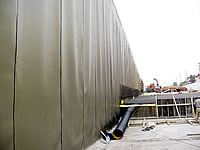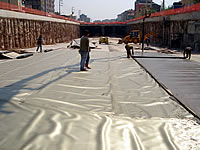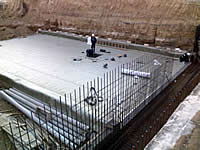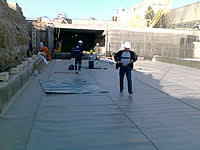Subways and Tunnels

Waterproofing is the second major criteria in the construction following the structural works. Water and moisture may cause corrosion and carbonation of the steel used in the reinforced concrete system which carries a vital risk for the structure. The best way of protecting the structure is by having a continuous waterproofing system for the construction. Especially in constructions totally below ground level like subways and some types of tunnels, a failure in the waterproofing may be vital. The economic life of the waterproofing system must be as long as the service life of the construction. Low quality materials with relatively less initial cost must strongly be avoided
ECB Geomembrane systems have proved their performance world wide in the subway and tunnel waterproofing works of various types of projects they were used since the mid 1960's with their long economic lives and very high aging resistant characteristics.
Subway and Tunnel Waterproofing



Subway systems are generally constructed with a combination of standard tunnel systems and cut & cover type tunnel systems. In the cut and cover type tunnels , the foundation, walls and the roofing slab is waterproofed like a box system. ECB Geomembranes are applied in single layers by loose laying and seam welding method for the waterproofing of the foundation, walls and the roofing slab .
For the foundation and roofing slab application, OC-Plan® ECB Geomembrane roll is loosely layed on the prepared concrete surface; than the second roll is loosely layed near the first geomembrane roll with an overlapping of 10 cm. The overlapped part is welded with double seam method using an automatic hot welding machine. The double seam is tested for 2 min applying 2 bar pressure using a manometer and a visual test is performed on the signal foil. The need for the usage of the geotextiles below and above the geomembrane is decided according to the surface and site conditions. After the geomembrane is protected with a plain concrete application of min 7 cm, scaffolding and reinforcement works may start. It is important to leave an enough portion of the geomembrane coming from the foundation waterproofing in order to continue the welding process for the wall applications.
For the wall application, OC-Plan® ECB Geomembrane rolls are hanged from the available height of the walls by temporary fixings. The hanged rolls are overlapped to each other with 10 cm. The vertically overlapped part is welded with double seam method using an automatic hot welding machine. The portion of the geomembrane coming from the foundation waterproofing is again welded with double seam method to the geomembranes coming from the wall waterproofing in order to have a continuous watertight system. All the double seams are tested for 2 min applying 2 bar pressure using a manometer and a visual test is performed on the signal foil. The wall application continues similarly in phases and are welded with double seam method to the geomembranes coming from the foundation and roofing slab to achieve a continuous waterproofing system.
The standard tunnel systems usually have a horseshoe cross section and the remaining horizontal part is waterproofed similarly as the foundation waterproofing. The most important criteria and difference in these type of applications is , first a geotextile layer of a minimum 500 gr/m2 weight is installed on the shot crete surface using special ECB roundels. Than the first ECB Geomembrane is hanged on the surface by welding the geomembrane to the ECB roundels using hand welding tools. The hanged rolls are overlapped to each other with 10 cm. The overlapped part is welded with double seam method using an automatic hot welding machine. All the double seams are tested for 2 min applying 2 bar pressure using a manometer and a visual test is performed on the signal foil.
NOTES : OC-Plan® ECB Geomembrane system has special ECB accessories. These are internal and external corners, roof ventilators, roof outlets, water outlets, emergency water outlets, sealing sleeves, cable feeds, ECB laminated metal sheets, etc. and are applied using hand welding machines to the geomembranes.

